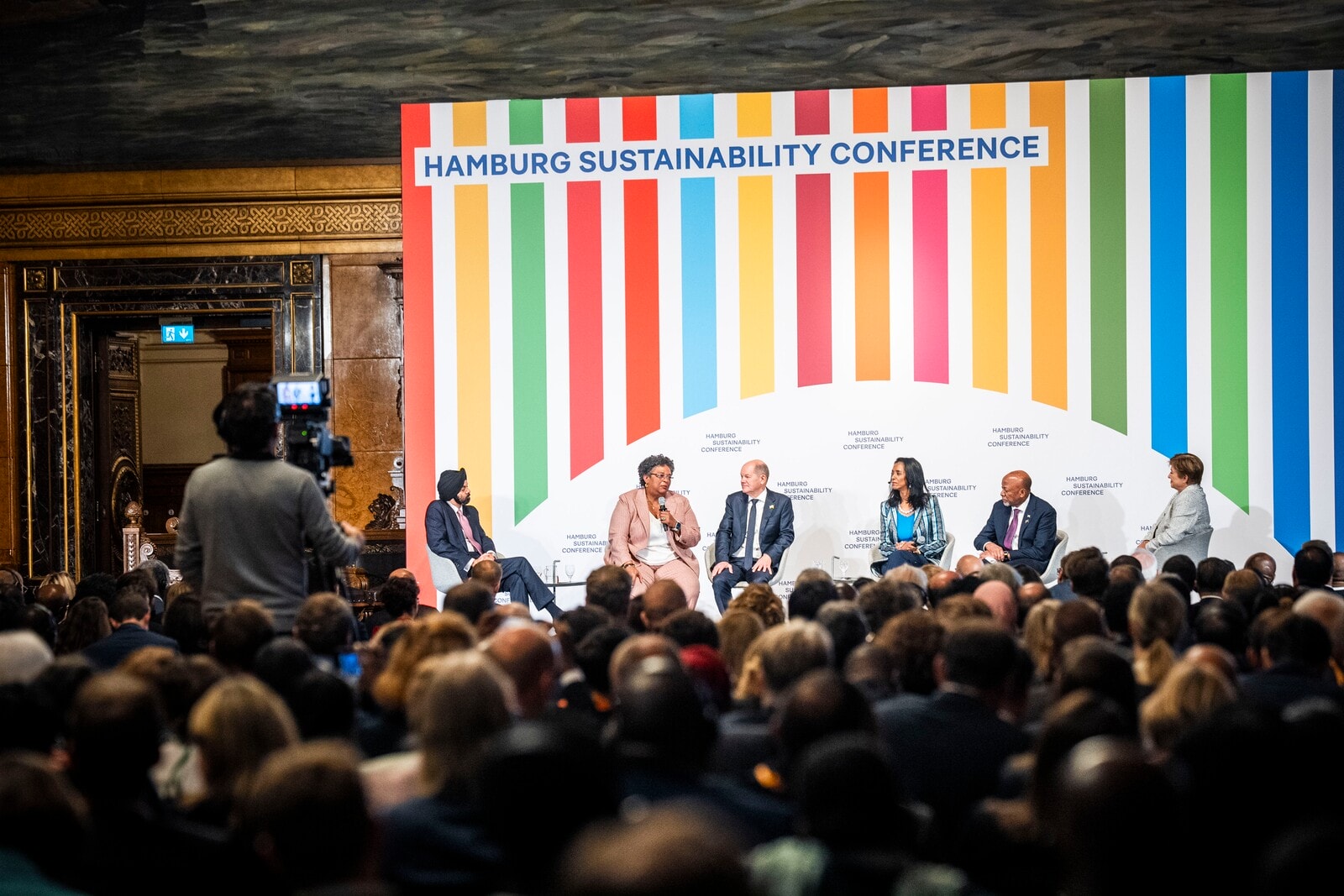EDITOR’S NOTE: THIS PIECE IS PART OF A SERIES EXPLORING THE SUSTAINABLE DEVELOPMENT GOALS. SEE THE INTRODUCTION TO THE SERIES HERE.
How to ensure quality early education: The UK case
Education is central to the underlying intentions of the United Nations Sustainable Development Goals. If we are to realize the ambition of a world without a poverty, in which serious action is taken to address inequalities and climate change, then this requires—by definition—cooperative and inclusive action, not only by governments, but by the public sector, private companies, NGOs, and individuals. This, in turn, relies on universal, high quality education which empowers people to take such action.
Sustainable Development Goal 4 captures this sentiment, pledging to:
Ensure inclusive and equitable quality education and promote lifelong learning opportunities for all.
In photo: Inaugural Meeting of “Education First” Meeting,Irina Bokova (right), Director-General of the U.N. Educational, Scientific and Cultural Organization (UNESCO) and Executive Secretary of the Committee; and with Babatunde Osotimehin, Executive Director of the U.N. Population Fund (UNFPA) and member of the Committee. Photo Credit: United Nations Media
Unlike Millennium Development Goal 2, which focused principally on primary education, SDG4 envisages education as a “lifelong” process, and this theme is developed further in the SDG4 targets. In particular, Target 4.2 recognizes that learning begins before primary school:
By 2030, ensure that all girls and boys have access to quality early childhood development, care, and pre-primary education so that they are ready for primary education.
This is important because there is a strong body of evidence which demonstrates the lasting impact of an individual’s early childhood experiences on their subsequent development. As Target 4.2 acknowledges, early years provision which is of high quality and accessible to all provides a strong basis for further learning. This article assesses the extent to which early years policy in England is focused upon this benchmark. In contrast to the Millennium Development Goals, the Sustainable Development Goals are specifically designed to require action by all countries, regardless of their economic or political circumstances. Although England has a high-income economy, the inequalities which persist in its early years provision mean that there is a real need to consider whether or not the system is moving towards the aspiration laid out in Target 4.2.
Related article: “MEETING EDUCATION FOR ALL (EFA): INSIGHT INTO THE CASE OF TANZANIA“
England’s disadvantage gap in educational attainment
There remains a gap in educational attainment between children from different socio-economic backgrounds. This disparity appears very early in a child’s life and is already firmly established by the time a child begins primary school. Analysis of the 1970 Birth Cohort Survey suggests that even when assessed at age 22 months, the difference between the average rank of children in the lowest and highest social class groups is 13 percentiles. A recent CentreForum report identified a gap of 4.3 months of development between disadvantaged and non-disadvantaged children at age 5 in 2015. Although this gap appears to have narrowed from 5.5 months since 2007, there is clearly a long way still to go if children are to begin primary school on an equal footing.
Why does this gap exist? A large part of the difference is explained by the home environment in which a child grows up, and particularly by parental involvement in learning activities (such as reading to their child, singing songs and nursery rhymes, playing with letters and numbers, and painting and drawing). In addition, however, quality and access to early years provision are a key part of the story. There is evidence that disadvantaged children have the potential to benefit most from high quality early education. Yet these children are less likely to access early education than are children from higher income families. A universal entitlement to free early education for three and four-year-olds was introduced in England in 1998. It has been extended over the years and currently stands at 15 hours per week for 38 weeks a year. The vast majority of children take up this entitlement, but the likelihood of doing so continues to be linked with socio-economic background: 98 per cent of 3-year-olds in the least deprived areas access the entitlement, as opposed to 90 per cent in the most deprived areas.
Indeed, there is a danger that this distribution of resources could in fact place disadvantaged children at further risk in three key respects: eligibility for the 30-hour entitlement; capacity of the early years sector; and quality of provision.
In addition, there is evidence that this free entitlement to early education does not necessarily guarantee the level of quality required to narrow the attainment gap. Analysis of the initial roll-out of the free entitlement in the early 2000s demonstrates that the policy did not result in a reduction in the disadvantage gap, as the expansion in provision which the initiative prompted took place in low quality settings.
It is also the case that quality of provision still differs according to level of deprivation. Ofsted data from 2013 indicate that there was a 10 percentage point gap in the proportion of non-domestic providers rated good or outstanding when comparing settings in the 20 per cent most deprived areas with those in the 20 per cent least deprived areas. Another study found quality to be similar in school-based settings but significantly lower in private, voluntary and independent settings located in deprived areas.
For a full mindmap containing additional related articles and photos, visit #SDGStories
The future direction of early years policy in England
Early years policy making in England does not appear to be sufficiently focused on addressing these barriers to achieving high quality, accessible early years provision for all. The universal, free entitlement to early education will, from September 2017, be extended to 30 hours per week for the children of working parents. In order to qualify, all parents in a family must be earning at least the equivalent of 16 hours per week at the national living wage and have a per parent annual income below £100,000. The intention of the policy is to promote parental (particularly maternal) employment, but there is a real concern that the policy may carry unintended consequences for the outcomes of disadvantaged children by placing at risk their access to high quality provision.
A recent CentreForum report, ‘Widening the gap?’, looks in detail at these issues. Alongside other forthcoming changes to childcare subsidies (the introduction of tax-free childcare and the roll-out of universal credit), the analysis contained in the report combines entitlements to government subsidy with estimated take-up. It finds that low income families which do not qualify for the 30-hour entitlement can be expected to receive an increase in childcare subsidies (due to the impact of universal credit), but that this increase will be lower than for higher income families who do meet the criteria for the additional free hours. In addition, children of non-working parents will not receive any increase in subsidy.
In other words, the government is making a very large investment in early years provision (an additional £1 billion per year by 2019-20), but these resources will be allocated so that children from poorer families, who have the most to gain from high quality early education, are likely to receive a smaller share. In light of the distance which still needs to be covered if the attainment gap on entry to primary school is to be eliminated, there are questions to be asked as to why expansion of provision for higher income families is being prioritized over investing in improving quality for disadvantaged children.
Indeed, there is a danger that this distribution of resources could in fact place disadvantaged children at further risk in three key respects: eligibility for the 30-hour entitlement; capacity of the early years sector; and quality of provision.
- Evidence relating to the educational benefits of full-time pre-school attendance compared with part-time attendance is mixed. A major study in England in the early 2000s identified no additional benefits associated with full-time attendance, but it is not clear whether there is an optimum level of attendance (between full-time and part-time) or whether this varies between different groups of children. Some American studies have identified a moderate positive impact of full-day, as opposed to half-day, attendance at kindergarten, particularly for disadvantaged children. Without more granular analysis of data from England, it is important not to assume that an additional 15 hours per week of early years provision would have no impact on the outcomes of disadvantaged children.
- There is already a shortage of early years places in some parts of England, and this problem appears to be worsening. The extension to the free entitlement will prompt an increase in demand for childcare places; the Department for Education has estimated that an additional 45,000 places will be required. Several local authorities which will be piloting the scheme have announced that they will be allocating higher funding rates for the additional 15 hours than for the core 15 hours. If this pattern is replicated during the national roll-out of the scheme then, alongside the context of increased competition for limited places, there is a danger that some providers will prioritise accommodating children who qualify for the full 30-hour entitlement at the expense of children eligible for only 15 hours of free early education. As a consequence, some children from low income families may be completely unable to access the core 15-hour entitlement; others may be clustered in low-demand slots or at sessional settings which are unable to convert to more flexible, full-time provision. Such a trend would be particularly concerning in light of evidence that the cognitive development of disadvantaged children tends to be greater in settings which are more socially mixed, rather than in those with high proportions of disadvantaged children.
- The average national funding rates for the free entitlement, announced by the government in November 2015, are higher than has previously been the case. However, there have been claims that they will still not be sufficient to cover the costs of delivery for certain types of providers. Whether or not the level of funding will result in shortfalls continues to be disputed, but it is clear that the sums being made available will not allow providers to invest in quality through measures such as upskilling or expanding their workforce or developing their premises. This will place a strain on quality not only for the additional 15 hours of the new, extended entitlement, but also for the core, universal entitlement of 15 hours per week.
 In the photo: The needs of disadvantaged children must be considered in facilitating access to education.
In the photo: The needs of disadvantaged children must be considered in facilitating access to education.
Next steps
There is a real need for the government explicitly to take into account the needs of disadvantaged children as details regarding the implementation of the 30-hour entitlement are decided and announced. This relates to three key projects.
- An early years national funding formula is expected to be announced later this year. This will be designed to establish a more equitable distribution of early years funding between local authorities. CentreForum argues that it should also include a clear and explicit weighting for deprivation, to ensure that there is a consistent focus across the country in securing high quality provision for disadvantaged children.
- The Department for Education will also be outlining an early years workforce strategy. We know that quality of workforce is integral to overall quality of provision and to raising child outcomes. If this is to bring significant improvement then it will need to offer coherent, evidence-based strategies for raising the overall quality, status and pay of the early years workforce and for enabling and incentivising providers to invest in the development of their staff.
- Evaluation of the 30-hour entitlement must include a thorough analysis of the impact of the policy on children’s outcomes, considering not only those who qualify for the extended entitlement but also those who do not.
Only by shifting the parameters of the debate in such ways will we be able to claim that England is moving towards meeting SDG Target 4.2, to ensure that all children have access to quality early education and care that provides solid foundations for primary education.
Recommended reading: “THE BOTTOM TEN COUNTRIES FOR FEMALE EDUCATION“
—















